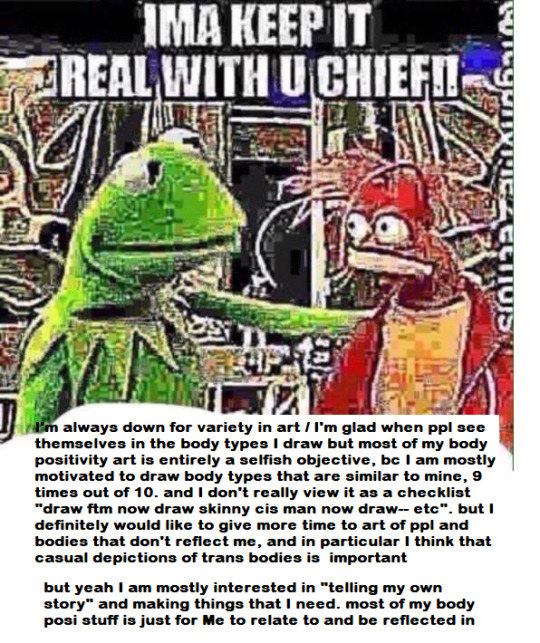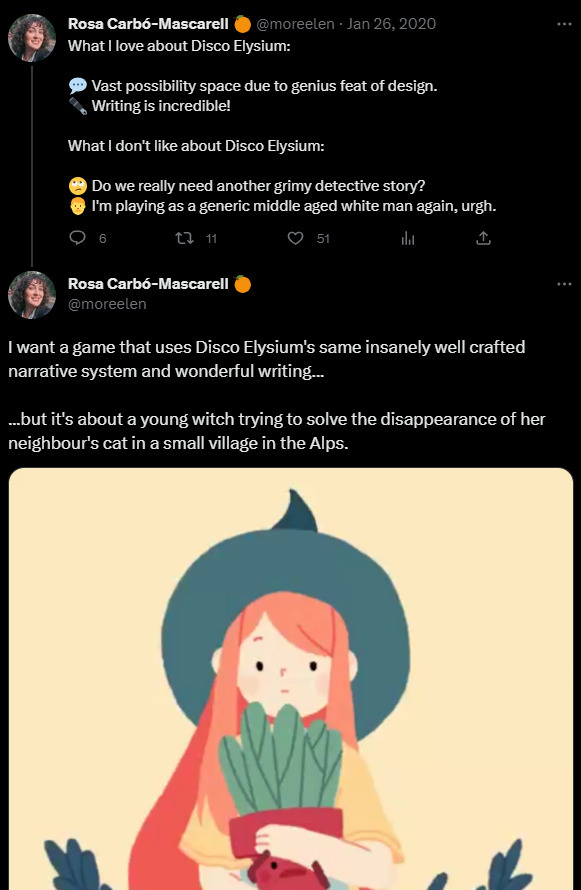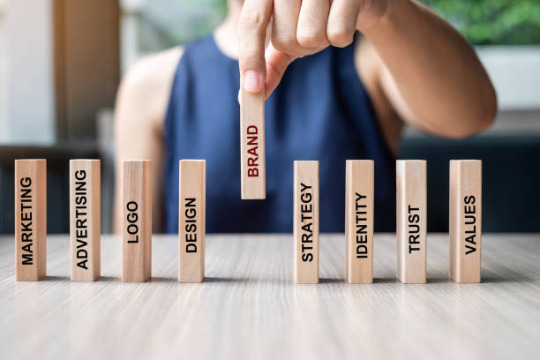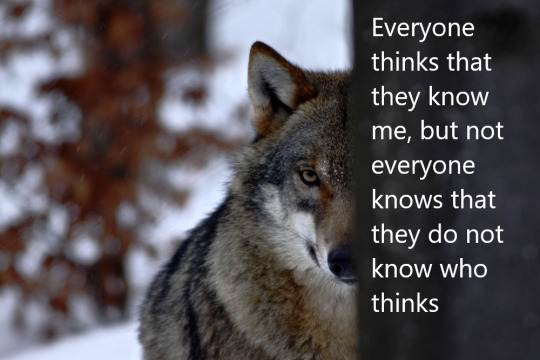#a demographic checklist
Explore tagged Tumblr posts
Note
Do you think you’d ever be interested in doing a line of semi nude portraits of different bodies? Transfem, trans masc, slim, medium, fat bodies etc? It’s totally cool if you aren’t I just love your art and I would love to see more prints from you perhaps :D

#sergle answers#I'm glad you like my art!!#it's really a very selfish endeavor for me as the target audience#and yeah there are body types I haven't focused on as much- I have some plans there actually. but I don't view my body posi art as#a demographic checklist#like diversifying is always good - esp just from a purely Art Perspective. being able to draw more than one thing well#but I do also like... drawing One Thing
273 notes
·
View notes
Text

I know I know we have already clowned on this person so much, but like step away from disco elysium brain for a second. The idea that stories have to be uplifting and palatable to all is bad. It closes your eyes to so much art that is vital to understanding people throughout cultural boundaries. Disco Elysium is a complicated, distinctly non American story that makes you step outside of your base assumptions and question the unquestionable. The story does this deliberately. Wanting that story to erode into something simple and idyllic- that is a cruel neutering. I feel like American progressive culture focuses too much on demographic diversity, and not enough on diversity of experiences and history. The need to make a checklist- you play as a disabled, non man! Queer themes! Etc. That takes away your ears towards a wide variety of stories that ARE queer disabled non white etc. Because you are looking for a hamfisted, virtue signaling obviousness, you are missing the intricate stories told by people who don't have your background. Your phd in politically correct American english. By valuing the ability to speak this progressive language, and policing the words used to describe someone's own experiences - you're not listening. You're missing out on art.
So yeah. If you close your ears to disco elysium because it's a grimy detective story with a white man (it's...not set in America but let's just let the concept of whiteness stay for simplicity). Then you're not actually accepting of diversity. You're accepting of the checklist.
#disco elysium is like. Not fucking brooklyn 99 or whatever.#also hey man what fucking cultural background is witch. or did you just say that so you could imagine someone in the beauty of the Alps#without that pesky swiss/italian/etc culture#central conflict? oh a missing cat#becauze what kinda media would make you face the issues with addiction and addicts and war and -#okay ive got off track but come on dude#disco elysium
410 notes
·
View notes
Text
Hamilton, Weaponized Wokeness, and the Internet’s Compulsive Guilt Complex
So we need to talk about Hamilton. If you’re part of a certain demographic that grew up with it in the mid-2010s, you probably remember the near-religious zeal that surrounded this musical. People were quoting it like gospel, crying over the mixtape, and breaking their banks to see it live. But now? Now, a lot of those same fans are backtracking, performing intellectual gymnastics to disown their past love. Why? Because Hamilton doesn’t check every box on today’s “woke” checklist. It’s revisionism, pure and simple, and it’s more a reflection on the critics than on Hamilton itself.
For starters, let’s talk about what Hamilton was at the time. This wasn’t just another musical; it was a cultural moment. Especially for Black and brown theater performers and fans, Hamilton was revolutionary. It put actors of color in roles traditionally whitewashed, blended contemporary music with Broadway, and reached audiences who’d never felt welcome in that space. In the sanitized world of theater, Hamilton was a bombshell, offering a fresh take that made young performers feel seen. It wasn’t perfect, but it was monumental.
The critiques I keep seeing—from both former fans and the politically progressive crowd—paint Hamilton as a whitewashed version of America’s founding, a sanitized theme-park history. But here’s the thing: Hamilton was never supposed to be a gritty historical documentary. It’s a musical about Alexander Hamilton’s ambition, his missteps, and his place in the American story—a story that is flawed, contradictory, and unfinished. Hamilton doesn’t hold up a perfect picture of America; it holds up a mirror to its messiness. And dismissing it for not being an all-encompassing critique of early America is missing the point.
Take Aaron Burr, Hamilton’s cautious, centrist foil. The musical presents Burr as someone who opts for safety over risk, and ultimately, inaction over bold moves. Burr’s passivity and Hamilton’s relentless drive serve as metaphors for the choices America has made: to act or to sit back, to strive for legacy or avoid the cost. Together, they reflect the push and pull of American ambition and apathy, neither of which are “good” or “bad.” They just are, and that’s complex. Erasing this because it’s not “woke” enough ignores the nuance Hamilton brings.
Another point these revisionist critics cling to is that Hamilton sanitizes its lead, making him into a hero. And yes, the real-life Hamilton was self-interested, married into a slave-owning family, and was often ruthless. But the musical doesn’t ignore this. It shows him as dogmatic, driven by his own ambition, and flawed beyond repair. He is, in many ways, a textbook example of the contradictions in America itself: deeply flawed, trying to belong, and ultimately, paying the price for his ego. This isn’t glorification; it’s tragedy.
Then there’s the critique that Hamilton is just “Obama-era liberalism” packaged with catchy tunes—a symbol of the old days of hope and “yes we can” that’s cringe-worthy in today’s climate. Fine. Hamilton does reflect that era of hope in America, where progress seemed possible. But slapping that label on it and moving on misses why it resonated then and why it endures. Hamilton cracked open the gates for diverse representation on Broadway, sparking conversations and productions that are still unfolding. Sure, it’s not as radical as we might want now, but that doesn’t erase its impact.
Let’s not forget that Hamilton was a product of its time and place—and one that challenged Broadway norms. Calling it “whitewashing” ignores the fact that it was a groundbreaking show for many Black and brown artists and fans. It was never intended to be the ultimate word on representation, and that’s something Lin-Manuel Miranda and the cast have made clear. The show was about opening doors, not being the final answer.
Yes, Hamilton deserves critique. It’s not above analysis or even condemnation. But this revisionist guilt trip, where we erase its impact or reframe it to absolve ourselves of loving it, is shallow. Critique Hamilton all you want—but let’s not pretend it wasn’t a moment, or that its flaws erase the doors it opened and the conversations it started. History, just like art, is complicated, and this need to revise or sanitize what we once embraced doesn’t make us more progressive; it just makes us short-sighted.
Here’s the thing: We can’t just rewrite our own histories because it’s uncomfortable to confront who we once were. Hamilton isn’t perfect, and neither is America, but both invite us to grapple with contradictions and reckon with legacy. Loving something flawed doesn't make us naïve—it makes us human. Instead of erasing the impact Hamilton had, maybe we need to remember what it meant, even in its messiness.
Because at the end of the day, our cultural milestones, like Hamilton, are pieces of our journey, for better or worse. Revisiting them with fresh eyes is part of growth, but denying their impact? That’s erasing our own stories. We can move forward without tearing down the things that got us here. After all, the story of America—of progress, failure, and trying again—is still being written. And like Hamilton himself, maybe the question isn’t whether it’s perfect but whether it’s brave enough to take its shot.
20 notes
·
View notes
Note
I was reading some old Reylo posts and came across a user on here saying that even if Rian Johnson had directed TROS, it still would've been bad, because of interference from higher ups (Rey Skywalker was a consistent theme across the two scripts - but imo, I think that might've just been because they were collectively mad she wasn't a Skywalker lol).
If this isn't an annoying and tiresome question, what do you think? It's hard to speculate but I do find it a bit fun, because there's always been that 'what if' for me that if Rian had done it, maybe it wouldn't have been awful... I guess the implication here is that, was TROS always going to be bad?
I'm ruminating on it a bit because it seems like Disney has kind of segmented the SW fanbases across their shows - Prequel stuff, worldbuilding stuff, OT stuff, and now the romance/Force storyline stuff. All of these combined elements is what made SW so potent, what made something like Reylo so powerful, but it's what makes it a hard brand to sell.
What we heard was that Kennedy asked Rian to do it, but he said he needed more time to write the script and Iger/DLF was unwilling to move the release date. I'm not sure how verified that ever was, but it's the most depressing fucking thing imaginable if true. The same short-term only, immediate profit and your quarterly bonus over the integrity of the company and the franchise which has been destroying Disney as a studio over the last decade or so.
I do think the most blame for tros must ultimately rest with Iger, but it's not like that absolves JJerio from responsibility for how bad it actually is.
I have answered this exact question before, and speculated on related stuff a few times, but unfortunately I haven't been able to find that post for you.
To me, if we learnt anything from DotF being a thing, it's that there was never anyone at the wheel, plotgate was totally true, and the directors were allowed to do whatever they wanted. If Rian had been making the third film from the start, I don't think they would have tried to impose any major story beats on him. The reason it became such a shitshow was The Book of Henry came out and they realised Colin's script was totally unacceptable way too late.
And once the can of meddling was open and you're back to JJ 'no thoughts, head empty' Abrams as a workman director, the suits were basically writing epIX with Terrio's incest fever dreams as connective tissue. They kept elements from Colin's version because they were trying to save time and use as much of the work which had already been done as possible. There was no commitment to any of those ideas, it's just incompetence and with no direction or ideas of their own, they were making a reddit checklist to try to please the whiners rather than writing any actual story.
Like, none of this would have happened if Rian were involved, because Rian would have written an actual story.
SW is mythology and very few people working at DLF seem to have ever understood that or have any idea what it means. Disney has segmented it because that's what they know, they want to have different product to sell to different demographics to maximise saturation and profit. That's their business model. They don't understand the foundation, the Saga itself, and its universal appeal, they seem content to let that stay dead and focus on compartmentalising and pandering to smaller, separate audiences.
34 notes
·
View notes
Text
Reference saved in our archive
Vitamin D is showing in study after study to have a massive impact on acute covid severity.
Abstract Background: Vitamin D is a steroid hormone that protects against viral infections by influencing innate and adaptive immune responses. The effectiveness of vitamin D3 supplementation in COVID-19 is unknown. The study’s goal was to elucidate the relationship between blood vitamin D levels and COVID-19 clinical outcomes by examining the effect of a single high dose of vitamin D3 on the length of hospital stay in COVID-19 patients.
Methods: The descriptive, retrospective study was performed from March to May 2021 at a referral center for patients with COVID-19, in Bam, Iran. A checklist consisting of demographic variables was used to gather data, and laboratory assessments of serum 25(OH) D were evaluated and documented. The connection between serum vitamin D and patient clinical outcomes was investigated after patients were given a single oral dose of 200,000 IU of vitamin D3.
Results: 71 COVID-19 patients were treated. Radiological results did not change substantially amongst individuals with various levels of 25(OH)D. After a single dosage of vitamin D3, mean blood levels of 25-hydroxyvitamin D increased considerably and the need for intubation and SpO2 decreased, and as did the respiratory rate in patients requiring hospitalization due to COVID-19.
Conclusion: A single administration of 200,000 IU of vitamin D3 significantly reduced the severity of COVID-19.
Keywords: vitamin D, COVID-19, outcome, pandemic
Zusammenfassung Hintergrund: Vitamin D ist ein Steroidhormon, das vor Virusinfektionen schützt, indem es die angeborene und die adaptive Immunantwort beeinflusst. Die Wirksamkeit einer Vitamin-D3-Supplementierung bei COVID-19 ist unbekannt. Ziel der Studie war es, den Zusammenhang zwischen dem Vitamin-D-Blutspiegel und der Gabe einer einzelnen hohen Vitamin-D3-Dosis auf die Krankenhausaufenthaltsdauer bei COVID-19-Patienten zu untersuchen.
Methode: Die deskriptive, retrospektive Studie wurde von März bis Mai 2021 in einem Referenzzentrum für Patienten mit COVID-19 in Bam, Iran, durchgeführt. Zur Datenerfassung wurde eine Checkliste mit demografischen Variablen verwendet und der Serumspiegel von 25-Hydroxyvitamin-D (25(OH)D) bestimmt und dokumentiert. Untersucht wurde die Assoziation zwischen Serumspiegel von Vitamin D und klinischen Ergebnissen. Die Patienten erhielten eine orale Einzeldosis von 200.000 IE Vitamin D3.
Ergebnisse: Es wurden 71 COVID-19-Patienten behandelt. Die radiologischen Ergebnisse veränderten sich bei Personen mit unterschiedlichen 25(OH)D-Werten nicht wesentlich. Nach einer Einzeldosis Vitamin D3 stieg der mittlere Blutspiegel von 25-Hydroxyvitamin D erheblich an. Dadurch wurden die Notwendigkeit einer Intubation herabgesetzt und der Sauerstoffpartialdruck sowie die Atemfrequenz bei Patienten, die aufgrund von COVID-19 hospitalisiert worden waren, signifikant verbessert.
Schlussfolgerung: Durch einmalige Verabreichung von 200.000 IU Vitamin D3 wurde die Erkrankungsschwere von COVID-19 deutlich verbessert.
Schlüsselwörter: Vitamin D, Covid-19, Ausgang, Pandemie
#mask up#public health#wear a mask#pandemic#wear a respirator#still coviding#covid#covid 19#sars cov 2#coronavirus
7 notes
·
View notes
Note
Here's my mini list about how to figure out if someone is a tryhard, and if you thereby should ignore them when it comes to recommending books. Obvs this is also paired with some sub conscious pattern recognition.
1) Cares too much about the author. Making mention of the author if it's relevant is ok. But some people will put too much weight on what the authors is, and who they are and let that influence the review. Also noticed especially with social media famous people where the author. So if the author's presented persona is brought into the review for no reason, it becomes a red flag. I don't often think there's any reason to really mention the author, unless it's a biography.
2) People who judge the author instead of the work. In some cases this can be valid, but in most cases the judgement of the author makes little sense in a review of the book. If you're reviewing a book, review the book.
3) Identity checklists in the review, especially if it's at the top, and they're counted as a positive, instead of a neutral fact. Yes having a lot of diverse identities can be a pro, especially if the book has diversity as a theme, but it shouldn't be presented as a grocery list for you to check off. A lack of elaboration can make it feel like the reviewer really didn't actually care that much about the identities listed beyond "They exist, so that means the book is good."
3.5) Too much random focus on the identities of the characters, but with no actual elaboration of how this is presented in the story. Just because the book has a lot of identities doesn't mean they're done well, or that the story is good. You can mention a hundred times that the gay character is gay, but is the actual character any good? Is the story written competently?
This is something that I noticed can really mess up a review streak. You can have two books with wildly different levels writing competency, and they get the same type rating and review, because the reviewer didn't actually care about more than the checklist. So a 10/10 book is treated as equal to a 4/10 because of the identities presented.
4) Double standards for reviews. Honestly pretty straight forward, are they excusing things for certain stories but condemning the exact same thing in another, for not actual reason? Are they biased against certain authors? Against certain demographics? Certain plot turns and arcs? No one is free of a little bit of bias, but when it's too obvious it's just not good.
This point actually goes back to author identity and the character identities. Author: A cishet author and a queer author can both write competent queer stories. If the only, and I mean ONLY reason the cishet author gets a worse grade is because of their identity, then that's a double standard. You're supposed to read the story on its own merits.
Checklist: Let's say you have an abusive character get their commuppance; if the reviewer thinks the abusive female character shouldn't have gotten punished, but are fine if a male character gets punished for the same crime.
I simplified those examples, and this point is mostly based on you noticing a pattern by the reviewer. If you actually are someone who follow reviewers, it'll at some point become something you notice.
--
24 notes
·
View notes
Text
Feeling excessively strange answering a job-survey. So, I did some job-applications and discovered that I still had an old Indeed account that hadn't been updated since 2020, so I tweaked my profile there. I was asked to take a demographics survey and I decided to go ahead on it in case it could get me favored by those looking for a diversity hire. I check a few boxes. I'm white, but I am female and have a disability. I've taken these things before. There was a new box on the checklist, one I hadn't seen before. "A part of the LGBTQA+ Community?" Normally I'd decline to answer (if only LGBT, for instance), but because more of the alphabet was listed, I answered "Yes." And promptly felt weird about it. I'm Asexual. This is, of course, what the A stands for (but I know some people mistakenly think it's "ally," which it is not. Honestly, a job service should know that it stands for Asexual because if A was for ally, they'd just be weeding out homophobes?) But, still, I felt a little awkward about it because here I am, not a lesbian or bisexual or pan, nor am I trans and answering this. It's like... yeah, I'm not straight, but not gay either and I guess those feelings I have long had of always being "a little on the outside" just came up. It's especially weird because I'm in a relationship where I'm "straight-passing" but...nope. And I guess I've always felt like I've wondered a little if asexuality is legitimate? I mean... not personally, I know what I am, but in terms of how the world thinks? Other aces feel this way sometimes? Why has a job-diversity survey gotten me so tizzied?
#asexuality#asexual#asexual problems#that feeling where you're not sure that you're valid even though you know who you are#maybe all the “you just need to get laid” insults I dealt with in my younger days are coming back on me#intrusive questions from even people like my sister#feeling gaslit by the world#having me all twitchy over a job survey
19 notes
·
View notes
Note
Hey! Please feel free to ignore or say f-off, but I really liked your "Free Offspring" joke and point of view. I am one of those 25+ women with little experience and was wondering if you had any advice from misadventures with my demographic?
In my case, it was easy to listen when they say don't date coming from a religious upbringing, and then to avoid further and say I was focusing on school. Now, I think I have good conversations with people, but I still find myself hung-up on trying to find the 'right partner' instead of just a person to kill time with, and am struggling on the dating apps.
There's a lot to be said for getting some experience. So go kill some time with people. You might end up finding a partner while doing that.
Be reasonable! Don't expect a guy to meet expectations you don't. Be very honest with yourself there.
Go over your personal checklist you have for the kind of guy you want to date with a red pen and get rid of anything that doesn't really matter.
As a Christian, your standards will by necessity already be high. Don't narrow your options by refusing to date someone you otherwise would due to hair, height, or eye color.
7 notes
·
View notes
Note
"and everything has to appeal to the widest demographic possible, which can mean sterilizing anything creative about the work so it becomes as palatable as possible."
If I may offer consolation, this seems to be because the internet has outsourced independent works to just about anyone.
Now anyone has the ability to make the cheap indie works that have niche, or even mass niche appeal. So what else do the big studios have left but the blockbusters?
Well a lot of issues with indie creators is funding. Editing a 100 page book for me is gonna be about $800. A lot of creators without access to a ton of cash are gonna struggle to put their art out there.
From a writers perspective, if you don’t make content that major publishers want you’ll likely never see mass endorsement or support. Most major publishing companies have specific stories and checklists that are marketable, and thus worth buying.
I honestly don’t see how I’m gonna get published anytime soon without 1) quitting my job so I can write full time which will never happen as long as I have bills or 2) running into thousands of dollars to fund self publication
12 notes
·
View notes
Text
REAL ESTATE AGENT ChatGPT Prompts
102 Powerfully Effective Real Estate Agent ChatGPT Prompts for 2024
Lead Generation & Qualification:
Draft a compelling Facebook ad targeting first-time homebuyers in [City].
Write a captivating Instagram post highlighting the benefits of working with a real estate agent.
Generate 3 unique email subject lines for a newsletter promoting a new listing.
Create a script for a cold call to a potential seller lead.
What are the best questions to ask a buyer during an initial consultation?
Develop a short survey to pre-qualify leads interested in [Neighborhood].
Write a follow-up email to a lead who showed interest in a recent open house.
Craft a personalized message to a lead who downloaded your home buying guide.
Generate a list of 10 questions to ask potential clients to identify their motivations and pain points.
Write a LinkedIn post highlighting your expertise in [Specific niche, e.g., luxury homes, relocation].
Property Descriptions & Marketing:
Write a compelling property description for a [Number] bedroom, [Number] bathroom home in [Neighborhood] with [Key features].
Generate engaging social media captions for a virtual tour of a new listing.
Create a catchy headline for a property listing with [Unique selling proposition].
Write a blog post about the top 5 things to consider when staging a home for sale.
Develop a script for a video walkthrough of a newly listed property.
Generate ideas for a unique open house event to attract potential buyers.
Craft email marketing content highlighting the best features of a specific property.
Write a press release announcing a new listing in a desirable neighborhood.
Create a brochure template showcasing the amenities of a luxury condo building.
Develop a landing page copy for a website promoting a new development project.
Buyer & Seller Communication:
Write an email explaining the home buying process to a first-time buyer.
Draft a message congratulating a buyer on their successful offer.
Create a checklist for sellers preparing their home for showings.
Write a script for handling objections about a property's price.
Develop an email template to provide updates to clients on market trends.
Craft a response to a buyer's inquiry about a property's HOA fees.
Generate a list of FAQs for sellers about the closing process.
Write a thank you note to a client for their referral.
Draft an email to a seller explaining how to negotiate multiple offers.
Create a guide for buyers on how to make a competitive offer in a hot market.
Market Analysis & Research:
Analyze the current real estate market trends in [City/Neighborhood].
Compare the pros and cons of buying vs. renting in [Area].
Research the average home prices in [Zip code].
Identify the key factors driving property values in [Neighborhood].
Generate a report on the best schools in [Area].
Summarize the latest news and developments in the local real estate market.
Provide insights on the impact of interest rates on home affordability.
Explain the different types of mortgages available to homebuyers.
Analyze the potential return on investment for a rental property in [Location].
Research the demographics and lifestyle of residents in [Community].
تحسين محركات البحث بالذكاء الاصطناعي
Productivity & Time Management:
Create a daily schedule for a real estate agent that includes time blocking for lead generation, client meetings, and administrative tasks.
Generate a list of essential tools and apps for real estate professionals.
Develop a system for organizing client files and documents.
Write a checklist for managing a property transaction from start to finish.
Identify time-saving strategies for real estate agents.
Create a template for tracking leads and their progress.
Develop a plan for delegating tasks to an assistant or team member.
Generate ideas for improving communication and collaboration with clients.
Write a guide on how to effectively manage your inbox and emails.
Create a system for prioritizing tasks and managing deadlines.
Content Creation & Social Media:
Write a blog post about the benefits of living in [Neighborhood].
Create engaging social media content showcasing your local expertise.
Develop a content calendar for your real estate business.
Generate ideas for eye-catching visuals for your social media posts.
Write a script for a short video highlighting your services.
Create a social media campaign to promote a new listing.
Develop a strategy for building your online presence and brand.
Generate ideas for engaging with your audience on social media.
Write a guide on how to use social media to generate leads.
Create a social media policy for your real estate business.
social media optimization dubai
Negotiation & Closing:
Develop a negotiation strategy for a buyer in a multiple offer situation.
Write a script for handling a counteroffer from a seller.
Generate a list of common closing costs for buyers and sellers.
Explain the role of title insurance in a real estate transaction.
Create a checklist for reviewing a purchase agreement.
Draft an email to a client explaining the different types of escrow accounts.
Develop a guide for navigating the appraisal process.
Write a script for handling a potential deal falling through.
Generate a list of resources for buyers and sellers during the closing process.
Create a closing checklist for ensuring a smooth transaction.
Legal & Ethical Considerations:
Summarize the Fair Housing Act and its implications for real estate agents.
Explain the duties and responsibilities of a real estate agent to their clients.
Generate a list of common ethical dilemmas faced by real estate professionals.
Draft a disclosure statement for a property with known defects.
Explain the importance of confidentiality in real estate transactions.
Create a guide for complying with local real estate laws and regulations.
Develop a policy for handling conflicts of interest.
Write a script for addressing a client's concerns about discrimination.
Generate a list of resources for staying up-to-date on legal and ethical issues.
Create a training module for new agents on fair housing practices.
Personal Development & Skill Enhancement:
Generate a list of professional development resources for real estate agents.
Identify key skills and qualities of successful real estate agents.
Develop a plan for improving your communication and interpersonal skills.
Write a guide on how to build rapport with clients.
Create a self-assessment tool for evaluating your strengths and weaknesses.
Generate a list of books and podcasts for real estate professionals.
Develop a plan for setting and achieving your career goals.
Write a guide on how to overcome challenges and setbacks in the real estate industry.
Create a personal brand statement that reflects your values and expertise.
Identify strategies for staying motivated and focused in a competitive market.
Other:
Write a referral request email to past clients.
Draft a response to a negative online review.
Generate ideas for community involvement and local partnerships.
Create a script for a presentation on the benefits of homeownership.
Develop a plan for building relationships with other professionals in the industry (e.g., lenders, inspectors).
Write a guide on how to choose the right real estate agent.
Generate a list of questions to ask when interviewing potential brokers.
Create a SWOT analysis for your real estate business.
Develop a business plan for your real estate career.
Write a script for a podcast interview about the current state of the real estate market.
Generate creative ideas for client appreciation events.
Draft a press release announcing a major achievement or milestone in your real estate career.
This list is just a starting point, and you can adapt and modify these prompts to fit your specific needs and goals. Be creative and experiment with different prompts to see what works best for you. Remember that ChatGPT is a powerful tool that can help you streamline your workflow, improve your communication, and ultimately achieve greater success in your real estate business.
#REAL ESTATE AGENT ChatGPT Prompts#REAL ESTATE AGENT#REAL ESTATE#ChatGPT Prompts#REAL ESTATE ChatGPT Prompts#ChatGPT Prompt#ChatGPT#تحسين محركات البحث بالذكاء الاصطناعي#personal branding strategist in dubai
3 notes
·
View notes
Text
house md episode checklist: house gets sexually harassed by someone of a dubious age, chase or foreman gets weirdly cruel about a certain demographic, cameron cries, house mentions cuddy's boobs and/or panties, wilson is kinda just there
4 notes
·
View notes
Text
Kickstart Your Fitness On How To Start a fitness Apparel Line: A Comprehensive Guide to Success

Launching a start-up fashion apparel business in the female fitness apparel niche is indeed a very engaging experience as it combines love for fitness clothing, fashion trends and, sports and business. The ultimate checklist to follow will help you to start the process of creating a profitable line of fitness wear.
Understanding of fitness clothing line

There are three main areas: choosing the best fabric for high performance, fabric weight, focusing on the stability, and adding in such things as the presence of moisture and breathing capability. Similarly everyday the athletic clothing line, the fitness clothing industry also top priority in terms of brand creation, market analysis, and marketing approach focused to the right demographic with keen interest in fitness and having a healthy lifestyle.
1. RESEARCH PLANNING

Understand the Market: Other recommendations include the following: Analyzing trends, target demographic, and players within the industry.
Choose Your Niche: To succeed in this competitive market, it is advisable to choose a niche, whether it is athleisure, performance wear, or sustainable materials.
Business Plan: Complete and submit the following plan as part of your proposal: plan: vision, goals, cost, and promotional plan.
2. PRODUCT DEVELOPMENT

Design Your Apparel: Other aspects of designs that needs to be taken into considerations include The purpose of the designs is to be unique that will appeal to the target audience.
Material Selection: Select materials of the highest quality that can resist wear and tear that often comes with many forms of physical training.
Prototype and Testing: Prototyping is the next step where one has to design and develop the prototypes of the concept and it is crucial to ensure that the gadgets created are functional, comfortable to wear and fashionable.
3. BRANDING AND IDENTITY

Brand Name and Logo: Namely, create a strong brand name and easily recognizable logo that would comply with the overall image of your brand.
Brand Story: Although a brand story does not necessarily identify neatly and distinctly with the audience, it is a building block by which you can create an emotional appeal as a way of communicating with the audience.
Brand Guidelines: It is imperative that what your brand represents on the Internet should resemble your offline brand image.
4. MANUFACTURING

Find a Manufacturer: Still using the example, try to research on the best manufacturer of the product that you would like to order within your set standard and financial capacity.
Sourcing Materials: Make sure that supplies of the chosen type of materials are constant.
Production Process: Supervise the manufacturing, or other processes, in order to ensure quality is not compromised.
5. LEGALITIES AND LICENSING

Business Structure: Decide on the right form of business to take (for example, LLC, sole proprietorship and others).
Licenses and Permits: The other important requirement includes; Securing the necessary business licenses and permits.
Trademark and Copyrights: Remember to safeguard your brand legally through the trademarks for the name, logo or any designs.
6. SETTING UP AN ONLINE PRESENCE

E-commerce Platform: Employ a friendly and easy to use e-business software to conduct your business with your customers.
Website Design: The need to create a website that is both attractive and easy to use cannot be overemphasized.
SEO and Content Marketing: Featured snippets must be implemented, and consistent development of content laced with SEO practices to accrue and maintain a loyal customer base should be the major goals.
7. MARKETING STRATEGY AND PROMOTION

Social Media Marketing: In this case, it is crucial to utilize social media platforms as a way of putting your brand out for people to see.
Influencer Collaborations: People follow the recommendations of their favorite personalities, especially in the online space, so use fitness influencers to advertise a new meal plan.
Email Marketing: In reference to the goal of increasing consumers’ purchases and maintaining their loyalty, it is vital to actively use e-mail campaigns to keep the target audience informed and involved.
8. LAUNCH AND GROWTH

Soft Launch: First, launch the product, specifically in a geographical location that will allow the research team to receive feedback before rebranding.
Official Launch: When your product is ready, ensure that it has a glamorous unveiling coupled with the promotions and campaigns.
Customer Feedback: Customers’ opinions can be heard through surveys, interviews or simply having them fill out a short questionnaire.
How Can You Choose the Suitable Fitness Clothing Manufacturer?
Choosing the right for fitness apparel brands and sports and fitness clothing brand by manufacturer involves several critical steps:
Research and Referrals

Always start your search online, and if you’re already connected to people in the fashion industry, ask for recommendations.
Evaluate Experience

In the case of sweaty gym and workout clothes made, the best manufacturers are those with specialization in manufacturing fitness apparel business apparels.
Check Quality Standards

Provide feedback on the quality control mechanisms used by the prospective suppliers and make sample demands.
Communication and Responsiveness

Guarantee that they are articulate and on the same page in terms of time.
Production Capacity and Flexibility

Check if they can fulfil your orders now and their ability to scale up for the future.
Cost and MOQs

You ought to compare costs and minimum order quantities (MOQs) that you will be willing to pay.
Ethical Practices

This means clothing manufacturers ensure that they adhere to the universally accepted ethical manufacturing standards.
FAQs

What is the first step in starting a fitness apparel line?
Ever before buying a product or designing one, a marketer needs to acquire some information in the niche market he intends to operate in.
How do I choose a niche for my fitness apparel line?
Keep it niche such as a sector, a category fitness clothing, or a material such casual clothing such as leisure-wear, sportswear, gym wear or eco-friendly material respectively.
What should be included in a business plan?
Describe your dream from day one, what you want to accomplish, how much money you will spend, solid business plan, how you will sell your product, and your business strategy and plan ROI.
How do I find a reliable manufacturer?
Research manufacturers, request samples, and assess their quality control, capacity, and ethical practices.
What legal requirements should I consider?
Choose a business model or structure to operate legally, Most legal business loans and structures require licenses and permits, and register a business name to safeguard your own business license and brand legally.
How can I build my brand identity?
It is also essential gym clothing brand to have a catchy brand name and logo that is geared towards attracting the intended audience to workout a fitness clothing line, as well as supporting them through a narrative.
What are the key elements of an online presence?
Establish an e-commerce site, create the storefront that consumers will want to frequent, and optimize the corporate website for search engine rankings.
How do I effectively market my fitness apparel line?
Get to market your own your own fitness clothing line, brand and products using social media marketing, brand association with influencers, e-mail marketing, and content quality.
Best advice to start a fitness clothing business
Allocation and the execution of goals and objectives, budget, sales and marketing strategies or the overall business plan is crucial. Brand your campaigns and target your audience through the proper use of social media, well-chosen influencers and online marketing. Marketing has to be properly developed, the web site has to be built in a way that it is easy to navigate, and contain optimized links that will bring buyers to the site. Remain open to change to stay in tune with emerging trends in the industry and target market, and with the opinion of the target customer to design better products and perform better business functions. Some of the tips involve; networking with professional industry players and looking for a mentor in the matter.
Conclusion
To sum up, it is crucial to outline the precise step-by-step plan when launching a fitness apparel line, from the accounting of the saturation in market and choice of the niche to creating the recognizable brand image. Hence, to create a niche fitness brand identity and carve out a space for itself within the cut-throat competition for quality fitness apparel and apparels, one must focus on quality fabrics, unique designs, and targeting the right consumer. And do not forget about using digital tools, addressing the audience through social networks, and being ready to adjust tactics according to tendencies and consumers’ responses. Fitness business or a new fitness clothing line or brand may sound a little blur, but if you are fully committed and employ adequate strategies, you can make a lot of money out of it such as workout clothes, gym apparel line and other new fitness clothing line and activewear manufacturers.
This would mean that undertaking this journey is more of a learning process and an experimentation process. It is crucial to remain connected with other professionals in the industry to be able to find support in the shape of a mentor, as well as always monitor the market situation to be able to manage on threats or even turn them into opportunities to sell workout clothes. To sustain the appreciation of the value these apparels have in the fitness industry or your own fitness clothing line or business and ensuring customer loyalty, one must strive to embrace a winning strategy that complies with the customer-oriented approach into your own fitness brand or fitness clothing line business.
#blog#clothing#fitnessapparel#business#fashion#clothing business idea#how to start a fitness apparel line
2 notes
·
View notes
Text
Build an Email List Fast!
📧 Email list building is crucial for any business looking to grow their customer base and increase sales. In fact, 59% of marketers say email is their biggest source of ROI! 💰
So, how can you effectively build your email list? Let's dive into some strategies that actually work!
💪First up, create valuable lead magnets that offer something of value to your audience in exchange for their email address. This could be a free e-book, checklist, or webinar. 📚
Next, optimize your website and landing pages for conversions. Make it easy for visitors to sign up for your email list with clear calls-to-action and compelling copy. ✍️
Don't forget to leverage social media to promote your lead magnets and encourage people to sign up for your email list. Engage with your audience and provide sneak peeks of the exclusive content they'll receive by subscribing. 📱
Additionally, consider running contests or giveaways to incentivize people to join your email list. Everyone loves the chance to win something for free! 🎁
And finally, don't underestimate the power of personalized, targeted email campaigns. Segment your email list based on demographics, behavior, and interests to deliver relevant content that resonates with your subscribers. 🎯
For more info check out my comprehensive email list building guide for more in-depth strategies and tips! #EmailMarketing #ListBuilding #DigitalMarketing 🚀
#online business#marketing#make money with affiliate marketing#affiliate marketing#work from home#make money online#home business#blogger#digital marketing#online marketing#email list#mailing list#email marketing trends#email marketing tips#email marketing services#email marketing#email marketing software#email mailing
3 notes
·
View notes
Text
Unveiling the Secrets of SEO: Tips to Get You Started.
Hey there It's your best digital marketing agency in dwarka, vrankup! let's get real about social media reporting and those KPIs that guide the ship. We're keeping it simple and AI-free, so buckle up, and let's dive in.
KPIs, or Key Performance Indicators, might sound like some techy jargon, but think of them as your compass in the vast sea of social media. They're your trusty tools for measuring how well you're doing, without drowning you in a sea of AI gibberish. Picture this – you're on a road trip, and KPIs are like your road signs, showing you the way and telling you if you're headed in the right direction.
First up, we've got **Engagement Rate**. It's like the popularity meter of your posts, measuring how many people are interacting with your stuff
Then there's **Reach and Impressions** – these are like the speakers at your party, making sure your music is heard. Reach tells you how many folks saw your content, while Impressions count how many times it was displayed. They're like the footprints of your content, showing you how far it's traveled and who's checking it out.
It measures the percentage of folks who clicked on your links after seeing your content. Imagine you're a street performer – your CTR tells you how many people dropped a coin in your hat after enjoying your act. A high CTR means your content is intriguing enough to make people want more.
The conversion rate is like the grand finale of your social media show. It's the percentage of people who actually do something meaningful after clicking your links – like signing up, subscribing, or making a purchase. This is where your audience goes from being spectators to active participants. It's like turning your audience into die-hard fans who want to join you on tour.
Let's not forget **Follower Growth** – it's like keeping track of your party guest list. Are new people showing up at your social media bash? This KPI helps you see if your content is attracting fresh faces or if it's time to switch up the tunes.
Audience Demographics are like knowing the tastes of your partygoers. It's about understanding who's vibing with your content – their age, gender, location, and interests. Imagine you're a DJ, and you know exactly what tracks will get your crowd dancing. Audience Demographics help you customize your content to match your audience's preferences.
Last but not least, we've got **Sentiment Analysis**. This is all about the vibes people are giving off. Are they cheering, booing, or just nodding along? It's like having a backstage pass to the crowd's emotions. Sentiment Analysis digs into comments, reviews, and mentions to give you a sense of how people feel about your brand.
In a nutshell, these KPIs are your party essentials for social media reporting. They're like your party checklist – making sure you're engaging, getting noticed, and turning bystanders into party animals. Engagement rates, reach, CTR, and conversion rates – these are the tools that help you host the best social media party in town.
Catch you later,
Digital marketing agency in Dwarka | Digital marketing company in Dwarka, vrankup
#seo company#seo#website designing company in gurgaon#noida#digital marketing agency in dwarka#website designing company in dwarka#website designing services in gurgaon#digital marketing company in dwarka#digital marketing#vrankup
2 notes
·
View notes
Text
While I’m Transformers-posting, honestly the concept of Strongarm as a character is kind of fascinating to me, because she’s like. One of those characters where I can see all the processes behind her creation and the fan reactions and why people were the way they around her.
Again, I came in late, so I can only talk about this as someone who was an outsider to the whole phenomenon, but it was fascinating seeing all those 2014-2015 era posts where people seemed like, really excited about her as a character. And a lot of it was very much in a very ‘checklist representation’ style tone. You know, you had a girlbot who wasn’t pink and who wasn’t slender and who was in a line of work women didn’t typically do (policing, rip). And I feel like that style of really liberal fandom feminism writing - going through a checklist of ‘not-often-done’ traits - was at least somewhat influential on the conceptualisation of her as a character, even if it obviously wasn’t the only influence it had on her character, along with being a part of her initial appeal*.
It also made subsequent backlashes in her writing interesting. Because I did see the pushback her episode with Windblade got. And I think at least a part of that pushback was like, okay, a part of it was because the writing of the series was far from The Best Ever lmao. And I know that a part of it was at least due to fandom shipping war bullshit. But I feel like, a little part of it maaaaay also be because at the time, a lot of normie liberal fandom feminist spaces were very insistent on the idea that women being represented as rivals was Bad and girls being friends was Good. So a lot of people tended to read media through that lens.
And while it is true that particular framings of such relationships and the way the trope get often presented in certain media does have roots in misogynistic ideas (women are all catty and bitchy and irrational about their dislike for each other, blah blah blah). I also recall listening to a podcast where the writer of the episode did actually talk about how she wrote it based on her own feelings and experience. And the way she and all the other normie liberal fandom feminist hosts were talking about it on the podcast, she seemed really proud of herself for writing that episode too!
And it’s this thing where I realise it’s an episode written by a woman, in a very typically male-dominated industry and a historically male-dominated franchise. And it was like. It got a certain amount of backlash from normie fandom feminist types too, due to it falling into kind of unfortunate implications.
It’s these kinds of moments, which like, I find kind of fascinating! As someone who could be considered a ‘fandom feminist’ by some metrics, and as someone who thinks ‘more women creating’ should be the prioritised goal wrt feminism and art.I don’t necessarily think I have a conclusion for this that isn’t something I kind of already said. But like, yeah! It’s one of those things where I feel like so much about it is more indicative of the type of system the show was conceptualised in. Wherein it is a franchise where historically speaking most of the creators were men, some of whom were adamant on there being no girlbots, and how all that baggage does make it a lot harder for women to write their own stories. As well as like, what sort of stories and what sort of girls get approved and are acceptable for mainstream media appealing to this particular demographic.
It’s also interesting looking at it in hindsight. Because she was very much a Smurfette, even if she didn’t fall into the conventional tropes and image of a Smurfette. And I know those Rescue Bots cartoons also had a Smurfette principle thing going on too. So it’s like. Interesting seeing it now, when the role of The Girl has become kind of... not a thing anymore in quite a lot of Transformers media.
*It’s not completely absent now, but I feel like this style of like, repbaiting(?) has less power over people these days.
#tabby says something#random#not putting it in the tags#i don't know how to make posts unrebloggable so i hope this doesn't blow up#edit: thanks dana!
3 notes
·
View notes
Note
Let me get this straight.
You were accused of several phobias based off of defense of a trans person that genuinely needed support? I just caught up on the posts and the responses and it looks like that person held some very problematic (cliche right-wing bs) beliefs but I can tell you didn’t support those beliefs per se. You wanted to prevent a trans person from being attacked during a bad spot in their life. You also didn’t mind sharing their fandom posts and being their friend because you knew that what they really needed was someone to help them. And it looks like they’re gone now?? Un-fucking-believable.
Now all of your mutuals are getting anonymously targeted by the same person that called you out? I am just a lurking witness but this person attacking you is the latent tr*nsphobe. They bullied and isolated someone for trying to help a struggling trans person. That is vile and I hope they rot in hell. Disgusting pos. Weaponizing tr*nsphobia is the number one no-no in fandom spaces and it’s a dead giveaway for who really care and who doesn’t. Helping a trans person through shit even when they are sharing harmful rhetoric takes balls. Good for you.

Gosh... This is always a heavy topic to talk about for me, especially when you put it THIS plainly. I think this is the most direct way to summarise the situation I've seen yet from a person that's not close to me (it is a compliment).
I must specify though - the "trans person" identified as trans man for about 13 years but since then revoked the term and now prefers to simply be described as GNC. In the end, he doesn't find the label he feels truly comfortable with, but this is still a person that is female in documents but male in fact and this IS an important bit in the whole story. Some people might argue that no matter what, but anyone not identifying with assigned gender counts as trans, that I get, but he has strong reservations and negative experience with the community that he shared multiple times - something the bully stalker you're referring to chose to ignore.
I think feeling identically homeless is an awful thing - he cannot line with the cis heteros (you can't just will yourself to identify as a straight girl when you are a gay man lol), but queer community has become ridiculously toxic with infights, imposing stereotypes on each other, ruining each others' spaces, cancelling each other over thoughts 'out of line', claims that someone's different experience harms the rest of the demographics upon being spoken of and god knows what else. You could figure that even in his younger years, he was excluded from his own identity and grossly bullied and misgendered because of the notion of "you do not belong in the queer community / you are not a REAL trans person if you support the [insert an opinion that has nothing to do with being trans]".

This is absolute fucking HELL from the sound of it, and I can't imagine LIVING it. You are so RIGHT for calling Alfred-chan (aka Clod Frollo, aka Slander Man) a latent transphobe. That they absolutely ARE. They do not see trans people (binary, nonbinary, generally GNC, whatever) as PEOPLE, as human beings with their own lives, history, opinions and differences. They see them as ideological soldiers in the "war" against them nasty white cissie hets and they are the EXACT garbage type that will exclude someone from their own gender/sexuality if they fail to match the checklist of strictly western libertarian opinions. They believe that to be trans or gay/lesbian is to have only certain beliefs on everything else that is not relevant. If not seeing trans people as people is not REAL transphobia, then I don't know what is.
From how you're talking you must be familiar with the cases of imposing very suffocating and concrete opinions and behaviour standards on a person for them to not be bullied as "not real" or "not proper" queer person. Some trans/GNC people will be conservative, some will be Christian, some will say 'instead of making 60 abortions just exercise protected sex already because abortion is a murder'. Because they're people, they come to different conclusions in this life, and no one should be put under obligation to assume only certain values to simply have their identity acknowledged.
ALSO from how you're talking you must be familiar with the situation of abusing the sympathy pool for selfish goals. This is exactly how #metoo got a dirty name. Alfred-chan used a very painful, vulnerable topic (transphobia) to fabricate lies and manipulate narrative with the goal of removing the bitch they disliked (yours truly) from the fandom. In general they are ridiculously nasty towards anyone that speaks against them trying to bully certain group of fans - people that clarify nuances on G3hrman as a character, insist that Maria is not "canonically a masculine lesbian" but instead is up to interpretation (that she is) or simply like G3hrmaria ship. They are terminally unable to see people (or fictional characters) outside of stereotypes and cannot acknowledge variety of identities and experiences. Yeah, I was proclaimed a witch to burn over the awful sin of trying to listen and help someone instead of throwing them away like a trash, but even before that they had quite a beef against me; they joined the fandom, lured some audience with cute mari4deline art and then decided to divide us into "normal fans" and "nasty misogynist lesbophobes without media literacy" just after the disco horse in the fandom started to die down. And I said NO YOU DON'T. Still, when they cannot harass people over reblogging a meme from me, they harass them for having an opinion on Maria that isn't 100% like their.

They do not care about trans PEOPLE, they care about trans 'identities'. These are different things. They appreciate diversity of flags and labels, but not diversity of experiences, opinions and backgrounds. And if you do not fit - you are a broken gear in the machine, you are not a proper 'soldier', and you must be thrown away. And if someone picks you up? They are the evil one, if not MORE evil. Kindness, patience and understanding are the bad things, but violence, cruelty and exclusion are what makes you trustworthy and good by their logic! True face of the fighters for "acceptance and kindness" as you can see! Fuck the Golden Ord- errrr I mean fuck this hypocritical corrupted witch-hunting nonsense.
----------------------------------------
I'd also not say that his rhetorics were "harmful". Again, Alfred-chan likes to twist what someone says to benefit their witch-hunter narrative. You can explain yourself with maximal logic, nuance and clarity, only for that person to ignore absolutely everything you said except for ONE thing they COULD twist against you, base everything around that thing and then play a victim. If you had the misfortune of knowing a 'narcissistic abusive mother' - the type of manipulation is shockingly similar. He was always ready to explain things properly but witch-hunters are not interested in removing the conflict - they are interested in removing YOU.
I also believe that free speech reveals the opinions, not creates them. Basically, opinions do not cause harm - PEOPLE do. If all it took someone to support this or that right-wing opinion is to read a post from a stranger online? Congratulations, a person found their tribe. It is GOOD if everything is revealed and everyone takes their place, it is GOOD if groups define their territories so you know where they are,. If many people believe in a "bad thing" - this means that many people ARE bad, and dividing and silencing them won't change the truth, only conceal it until it inevitably breaks through. Scaring people never changes their hearts, only makes them strike HARDER when they're ready to do so. Like what in the Brador people try to say with hating the truth revealed SO much? sdfjhdshghds
Me and him argue quite often, but when you befriend someone, it is a very bad thing to argue with them publicly. It borders the level of abusing a friend. If you have a friend that consistently shames you on public - this is not a good friend, and you should inform them that you are not their means of looking virtuous before some strangers/guests. On the brighter note - yes, the person is gone from Tumblr, but he is living his better life now. He got a therapist, he goes outside more often, he found a new passion that gave him sense of purpose, overall his life is getting better.. and he is happy that I get to be a part of it!
#personal#/vent#/negative#ask replies#thank you for letting me get this off my chest as i need to do it from time to time#you are absolutely correct that alfred-chan doesn't care about trans people but only about bullying those they dislike under guise of-#-noble intentions#i had a post about it too but yes - abusing the society's sympathy pool hurts EVERYONE#both the people that witch-hunter alienates and the people they claim to protect#they always feel attacked by someone not acting like they want them to those control freaks#yet again - with my wish to reveal the truth instead of keeping it veiled for some false ephemeral convenience-#-i should have my Rom kinnie privileges taken away and become someone else xd#maybe simon lol lol lol lol lol
4 notes
·
View notes